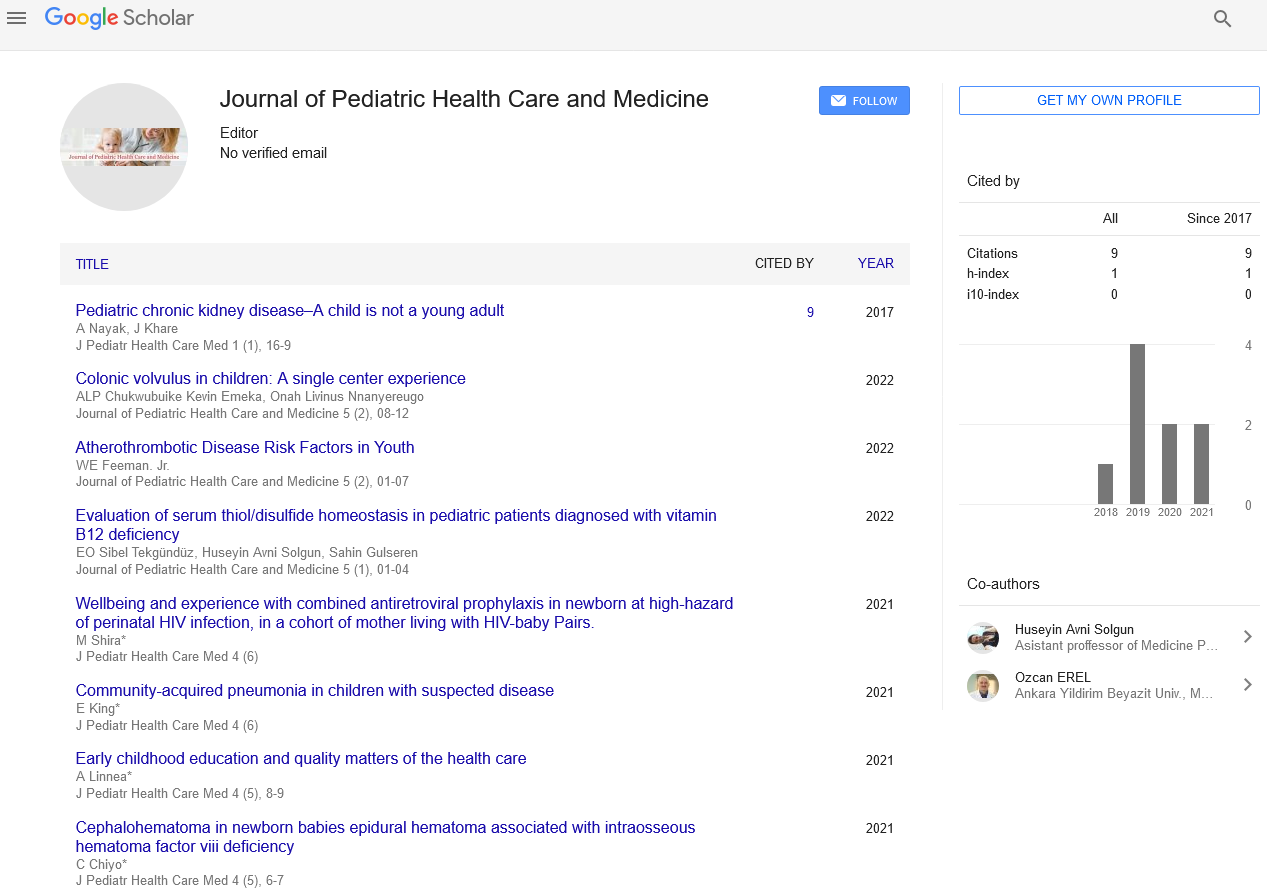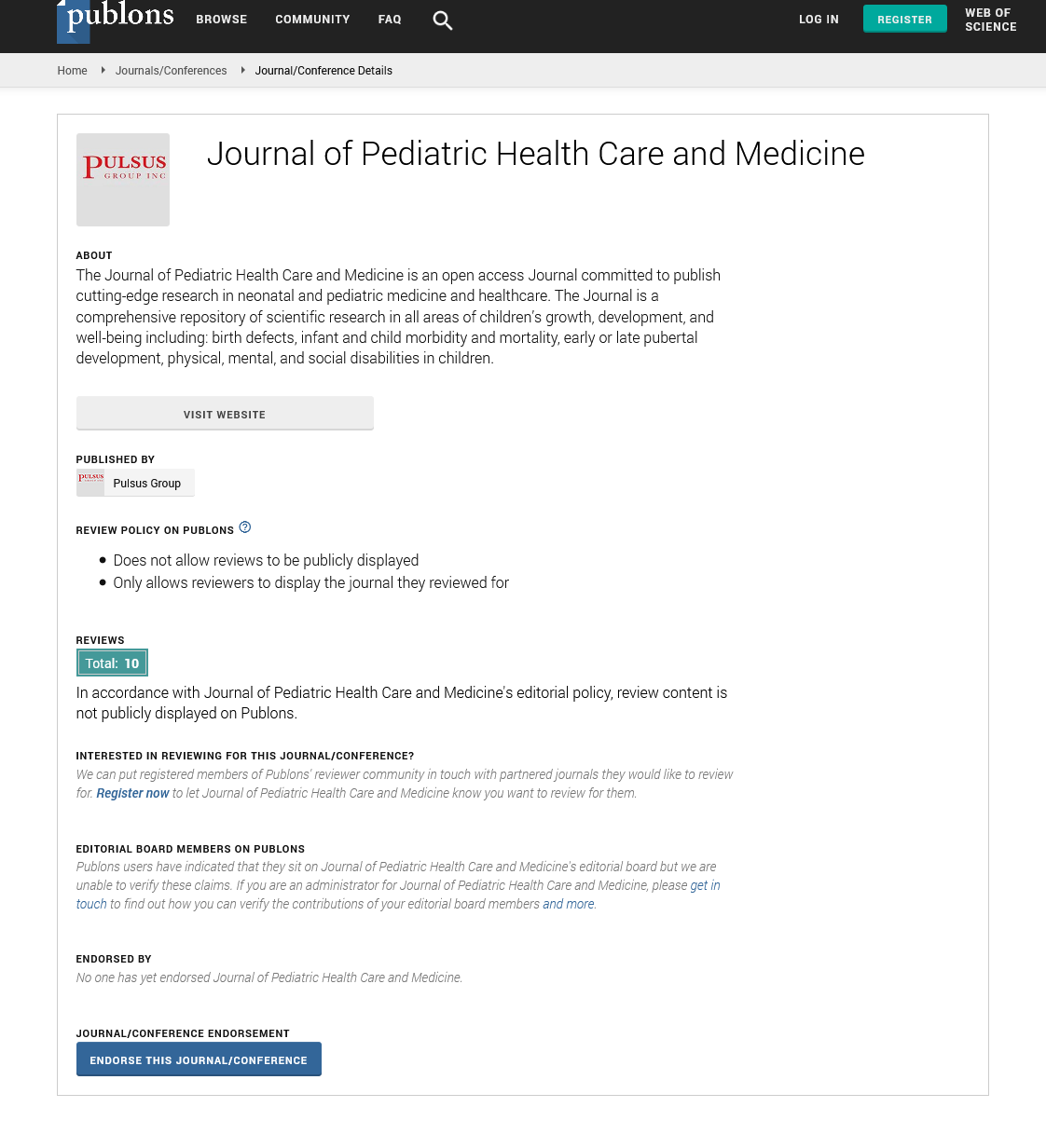Reduction of symptoms in Autistic children's by increase in AMP-activated Protein Kinase during exercise
Received: 12-Jan-2022, Manuscript No. PULJPHCM-22-4112; Editor assigned: 15-Jan-2022, Pre QC No. PULJPHCM-22-4112; Accepted Date: Jan 15, 2022; Reviewed: 20-Jan-2022 QC No. PULJPHCM-22-4112; Revised: 24-Jan-2022, Manuscript No. PULJPHCM-22-4112; Published: 29-Jan-2022, DOI: 10.37532/ puljphcm.2022.5(1).11-12
Citation: McHenry S. Reduction of symptoms in Autistic children's by increase in AMP-activated Protein Kinase during exercise. J Pedia Health Care Med. 2022; 5(1):11-12.
This open-access article is distributed under the terms of the Creative Commons Attribution Non-Commercial License (CC BY-NC) (http://creativecommons.org/licenses/by-nc/4.0/), which permits reuse, distribution and reproduction of the article, provided that the original work is properly cited and the reuse is restricted to noncommercial purposes. For commercial reuse, contact reprints@pulsus.com
Abstract
One of the neurodevelopmental illnesses is Autism Spectrum Disorder (ASD). Regression autism affects about one-fifth of children with ASD. The Adenosine Monophosphate (AMP)-Activated Protein Kinase (AMPK) regulates the balance of ATP metabolism in mitochondria, which is dysfunctional in regressive autism. This sensor kinase has been found to help in axonal development in studies. Exercise has been indicated as one of the most powerful variables in increasing mitochondrial activity and AMPK levels. Physical activity has been shown to boost social abilities. Physical exercise programs, when properly structured, may create an enjoyable and safe environment for children to engage with one another. Above all, we expected that physical activities may improve mitochondrial activity and lessen autistic children’s symptoms.
Keywords
Autism spectrum disorders; Adenosine monophosphate; Threonine protein kinase
Introduction
One of the neurodevelopmental illnesses is Autism Spectrum Disorder (ASD). Early infancy is a time of rapid brain development and essential learning and development abilities. Children with autism spectrum disorder also face problems with motor (muscle) skills, including balance and coordination. It is also the most common period for an initial autism diagnosis and the most effective time for early intervention. Regression autism affects around one out of every ten children with ASD, defined by normal development until the age of one or two, followed by a regression that significantly marked by reduced language ability [1].
Interacting with people is difficult for a youngster with ASD. Some of the most typical indications include issues with social skills. They may desire close connections but lack the skills to do it. Differences in communication and social interaction define these circumstances. Anxiety and intellectual incapacity are two of the most prevalent mental comorbidities linked to autism. Restricted and repetitive interests or patterns of behavior are common in people with ASD. Co-morbidities such as mitochondrial dysfunction, which is more frequent in children with regressive autism, are present in certain children with ASD [2].
Mitochondria are organelles that create the energy carrier Adenosine Triphosphate (ATP). Adenosine Monophosphate (AMP)-Activated Protein Kinase (AMPK), a serine/threonine-protein kinase that functions as a critical regulator and sensor, accurately controls the balance between ATP synthesis and consumption [3]. Studies have revealed that this sensor kinase can be useful in axonal development in autistic individuals with aberrant axonalpath discovery [4, 5].
Exercise has been recommended as one of the most potent mechanisms in increasing mitochondrial activity and AMPK levels [6, 7]. Physical workouts have been shown in several trials to help patients improve their performance. Physical exercises have been shown in research to minimize stereotypic tendencies in both autistic and mentally retarded persons [8]. It’s also been proposed that the optimal time to intervene and treat children with ASD is when they’re between the ages of 2 years and 4 years [9]. On the other hand, the prevalence of playing computer games among youngsters, which leads to a lack of exercise, may exacerbate the problem.
In addition to the foregoing, we anticipated that physical activities such as aerobic controlled workouts and age-specific sports might be beneficial in increasing mitochondrial activity. In this sense, we believe that increasing mitochondrial activity will promote brain growth and, as a result, diminish autistic children’s symptoms.
Discussion
ASD has a diverse genetic architecture that varies from person to person. The genetics that underpin ASD are still an active topic of research, and the present identification of ASD is primarily dependent on observation of behaviors. Studies have indicated that physical activities can assist patients enhance their performance. Physical activities have been demonstrated to reduce stereotypic tendencies in autistic and mentally retarded people in studies. Children with autism who took part in physical exercise programs created specifically for them improved their social and communication skills significantly. Horseback riding, different sorts of group play, running/ jogging programs, and exergaming were among the activities. According to studies, physical activity has been shown to boost social abilities. Physical exercise programs, when properly structured, may create an enjoyable and safe environment for children to engage with one another. To put it another way, they may be great places to practice social skills. Furthermore, animalrelated activities give youngsters with an enjoyable approach to engage both nonverbally and verbally.
REFERENCES
- Lainhart JE, Ozonoff S, Coon H, et al. Autism, regression, and the broader autism phenotype. Am J Med Genet. 2002; 113: 231-237.
Google Scholar Cross Ref - Frye RE, Rossignol DA. Mitochondrial dysfunction can connect the diverse medical symptoms associated with autism spectrum disorders. Pediatr Res. 2011; 69:41R-7R.
Google Scholar Cross Ref - Sanz P. AMP-activated protein kinase: structure and regulation. Curr Protein PeptSci. 2008; 9: 478-492.
Google Scholar Cross Ref - Courchesne E. Brain development in autism: Early overgrowth followed by premature arrest of growth. Ment Retard DevDisabil Res Rev. 2004; 10: 106-111.
Google Scholar Cross Ref - Amato S, Man HY. AMPK signaling in neuronal polarization: Putting the brakes on axonal traffic of PI3-Kinase. Commun Integr Biol. 2012; 5:152-155.
Google Scholar Cross Ref - Reznick RM, Shulman GI. The role of AMP-activated protein kinase in mitochondrial biogenesis. The Journal of Physiology. 2006; 574:33-39.
Google Scholar Cross Ref - Richter EA, Ruderman NB. AMPK and the biochemistry of exercise: implications for human health and disease.Biochem J. 2009; 418: 261-275.
Google Scholar Cross Ref - Elliot RO, Dobbin AR. Vigorous, aerobic exercise versus general motor training activities: Effects on maladaptive and stereotypic behaviors of adults with both autism and mental retardation. Journal of Autism and Developmental Disorders. 1994; 24: 565-576.
Google Scholar Cross Ref - Courchesne E, Pierce K, Schumann C, et al. Mapping Early Brain Development in Autism. Neuron. 2007; 56: 399-413.
Google Scholar Cross Ref






